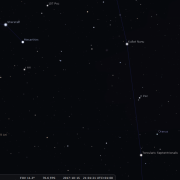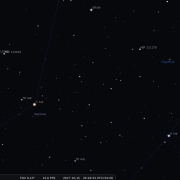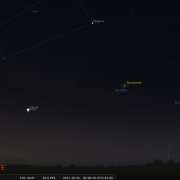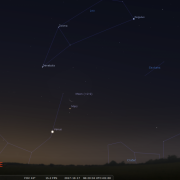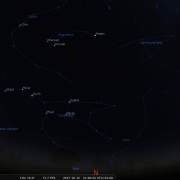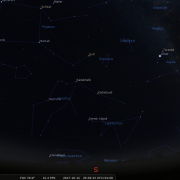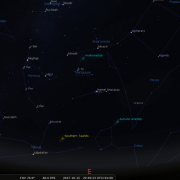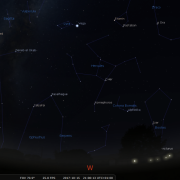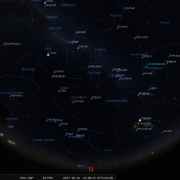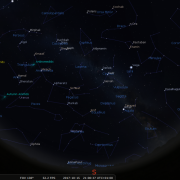Note: The first of the new season of WDAS Monthly meetings is on Tue October 3rd
Welcome to the WDAS monthly newsletter for October 2017: a digest of the month's latest contributions to our website. Below you'll find Society News, Sky Notes and In-Focus articles printed in full. There's also future events, and trailers for other articles which appear in full on the website - just a click away!
Society News
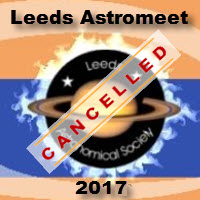 Those of you looking forward to the Leeds Astromeet this year will sadly have to keep looking, cos it’s not on, cancelled, postponed, deceased?..The comment on the Leeds website reads as follows:
Those of you looking forward to the Leeds Astromeet this year will sadly have to keep looking, cos it’s not on, cancelled, postponed, deceased?..The comment on the Leeds website reads as follows:
Leeds Astronomical Society has decided to cancel this year's Astromeet conference at Leeds University. The committee took this decision reluctantly, aware that there will be much disappointment, but after careful consideration. The reasons for cancellation include: financial constraints related to funding; rising costs at the current venue, and a number of other administrative concerns. Hopefully this isn't a binding decision - and should an Astromeet be proposed for 2018, details will appear on the New Year website.
Let’s hope it’s just a glitch this year, but it would not be a surprise if Astromeet became a biannual event.
This year’s event was early in the month in an effort to minimise the effect of moonlight. Conditions on the evening were encouraging with cloud forecast to clear away to the south. This turned out to be the case, but was painfully slow so that the moon and Saturn were initially obscured.
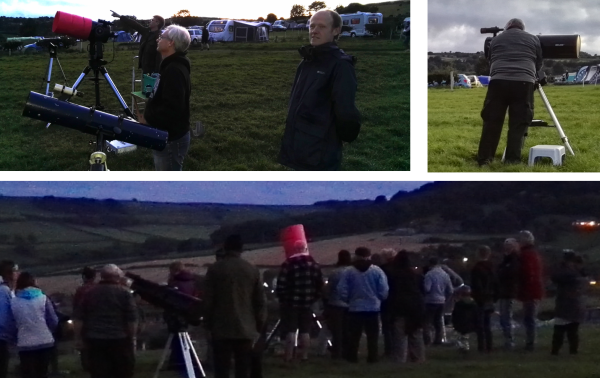
With four scopes deployed in good time, interest from the campsite was considerable and a sizeable crowd waited for darkness or the moon and Saturn to appear. This allowed time for Mark to demonstrate the scale solar system, with help from the audience, who were keen to assist. Eventually the moons face was uncovered, before Saturn emerged from the edge of the stubborn cloud bank. Both objects drew gasps of delight. Given the moonlight, deep sky objects were not at their best, but our usual menu of targets still seemed to flame the curiosity of those at the eyepiece.
Around 22:00h the event slowly wound down as expected cloud started to encroach from the NW, though as we had pretty much seen what we set out to show, we were quite happy with our evenings work.
This year’s trip over to Westerdale (15th Sept) coincided with cloud and eventually rain, preventing any observations outside. But as we know Esk Valley folk are a hardy breed, and in spite of the weather a good turnout gathered at the village hall.
Plan B was put into effect; ie the indoor show. This was augmented by a look at the Cassini mission at Saturn, which ended that very day. There were lots of questions, so i think people were interested, certainly the feedback was very positive. I guess if plan A falls victim to the weather, a good plan B is the next best thing...and it’s always nice to meet up with our member, John Randles, who acted as MC for the duration. Needless to say we have already been asked to pencil in a date next September.
C +
Started off the season reasonably well, but lost momentum midsummer, with a few opportunities missed. Inconsistent latter half, with one or two highlights.
Summary: Must try harder.
The society meetings restart in October the date is Tuesday 3rd (not 4th as incorrectly stated last month).
Apart from a roundup of our summer activities and a look at the current sky, Mark will be giving a short talk on Cassini and Andi hopes to have a talk ready too. Hope you will be able to join us (see WDAS diary for venue and time etc )
Our open nights at the Bruce Observatory recommence on Sunday 8th Oct starting from 19:30h. As always if you are unsure about the weather prospects on the evening contact Mark.
Sky Notes
In this month's Sky Notes:
Planetary Skylights
Evening

 Saturn gradually edges toward the west horizon throughout October, but remains readily observable all month. The rings are favourably orientated, but you will have to wait for those steadier ‘seeing’ moments to fully appreciate this wonderful spectacle. View on the 24th around 18:30h when a Crescent Moon lies above Saturn.
Saturn gradually edges toward the west horizon throughout October, but remains readily observable all month. The rings are favourably orientated, but you will have to wait for those steadier ‘seeing’ moments to fully appreciate this wonderful spectacle. View on the 24th around 18:30h when a Crescent Moon lies above Saturn.
 At Magnitude +5.65 Uranus should be easily visible in a pair of binoculars, however to discern its very small grey/green disk a telescope will be required. The planet lies over in the east toward the bottom of the ‘V’ in Pisces, not far above Torcularis Septentrionalis, however the best way to locate it will be by using Sheratan and Mesarthim in Aries (the crooked leg of the ram) and sighting down five times the distance between them, and then up one. Hopefully you should spot ‘Herschel’s planet’ The moon lies 4 degrees below on the 6th
At Magnitude +5.65 Uranus should be easily visible in a pair of binoculars, however to discern its very small grey/green disk a telescope will be required. The planet lies over in the east toward the bottom of the ‘V’ in Pisces, not far above Torcularis Septentrionalis, however the best way to locate it will be by using Sheratan and Mesarthim in Aries (the crooked leg of the ram) and sighting down five times the distance between them, and then up one. Hopefully you should spot ‘Herschel’s planet’ The moon lies 4 degrees below on the 6th
 Neptune is located to the south east in the constellation of Aquarius, but you will require a telescope to identify it. It resides below the asterism known as the ‘water jar’ not far beneath Lamda Aquarii. Through a telescope Neptune resembles a tiny blue/grey disk. The Moon lies lower left on the 3rd.
Neptune is located to the south east in the constellation of Aquarius, but you will require a telescope to identify it. It resides below the asterism known as the ‘water jar’ not far beneath Lamda Aquarii. Through a telescope Neptune resembles a tiny blue/grey disk. The Moon lies lower left on the 3rd.
Morning


 Venus and Mars reside in the eastern dawn sky. View around 06:00h at the start of October, when Venus is unmistakeable, a brilliant object seven degrees or so above the horizon. Mars resides just below and left. During the first week of the month Venus tracks downwards, whilst Mars gains a little in altitude, the two passing closest on the 6th. This will be a splendid sight in a telescope. Thereafter the two go their separate ways, Mars up, Venus down. But view again on the 17th and 18th when a Crescent Moon passes by both planets.
Venus and Mars reside in the eastern dawn sky. View around 06:00h at the start of October, when Venus is unmistakeable, a brilliant object seven degrees or so above the horizon. Mars resides just below and left. During the first week of the month Venus tracks downwards, whilst Mars gains a little in altitude, the two passing closest on the 6th. This will be a splendid sight in a telescope. Thereafter the two go their separate ways, Mars up, Venus down. But view again on the 17th and 18th when a Crescent Moon passes by both planets.
Meteors & Comets

The Orionids (Oct 16- 27) are the months most reliable shower, peaking this year on Oct 21/22. Like the Eta Aquarids that occur in May, Orionids are associated with Comet Halley, but are more favourable for northern hemisphere observers due to the radiant being situated high in the S by early morning hours. Orionids are swift, often producing persistent trains. Peak rates can exceed 20 per hour.
The weak Piscid shower has three peak dates, Oct 13th being the optimum one. Observed rates are little better than sporadic levels - around 3-7 per hour. Piscid meteors are often slow, of long duration, but not very brilliant. Strong moonlight will interfere this year.
Perhaps the most interesting shower is the Giacobinids or Draconids (Oct 6 -10th peaking on the 8th) which are associated with the periodic comet Giacabini- Zinner (6yrs) The shower is very erratic, but can produce outbursts of activity. There is apparently evidence to suggest that this may occur this year The BAA suggest observing between 11pm and 3am on the evening of the 8th, although strong moonlight will be present in this period.
October 2017 Sky Charts
|
Looking North
Mid-October - 21:00h |
Looking South |
|
Looking East
Mid-October - 21:00h |
Looking West
Mid-October - 21:00h |
| Northern Aspect Mid-October - 21:00h |
Southern Aspect Mid-October - 21:00h |
Additional Image Credits:
- Planets and Comets where not otherwise mentioned: NASA
- Sky Charts: Stellarium Software

